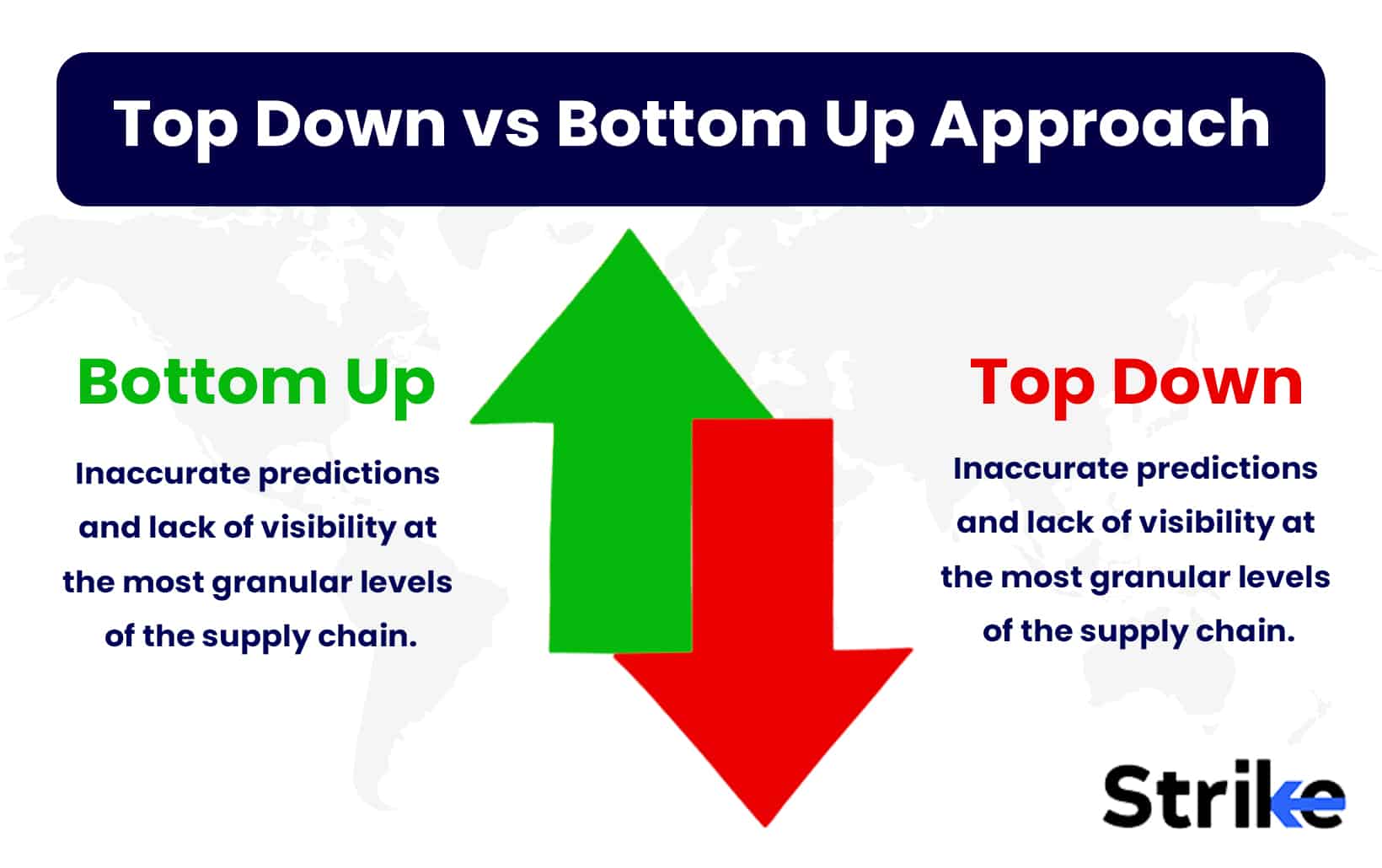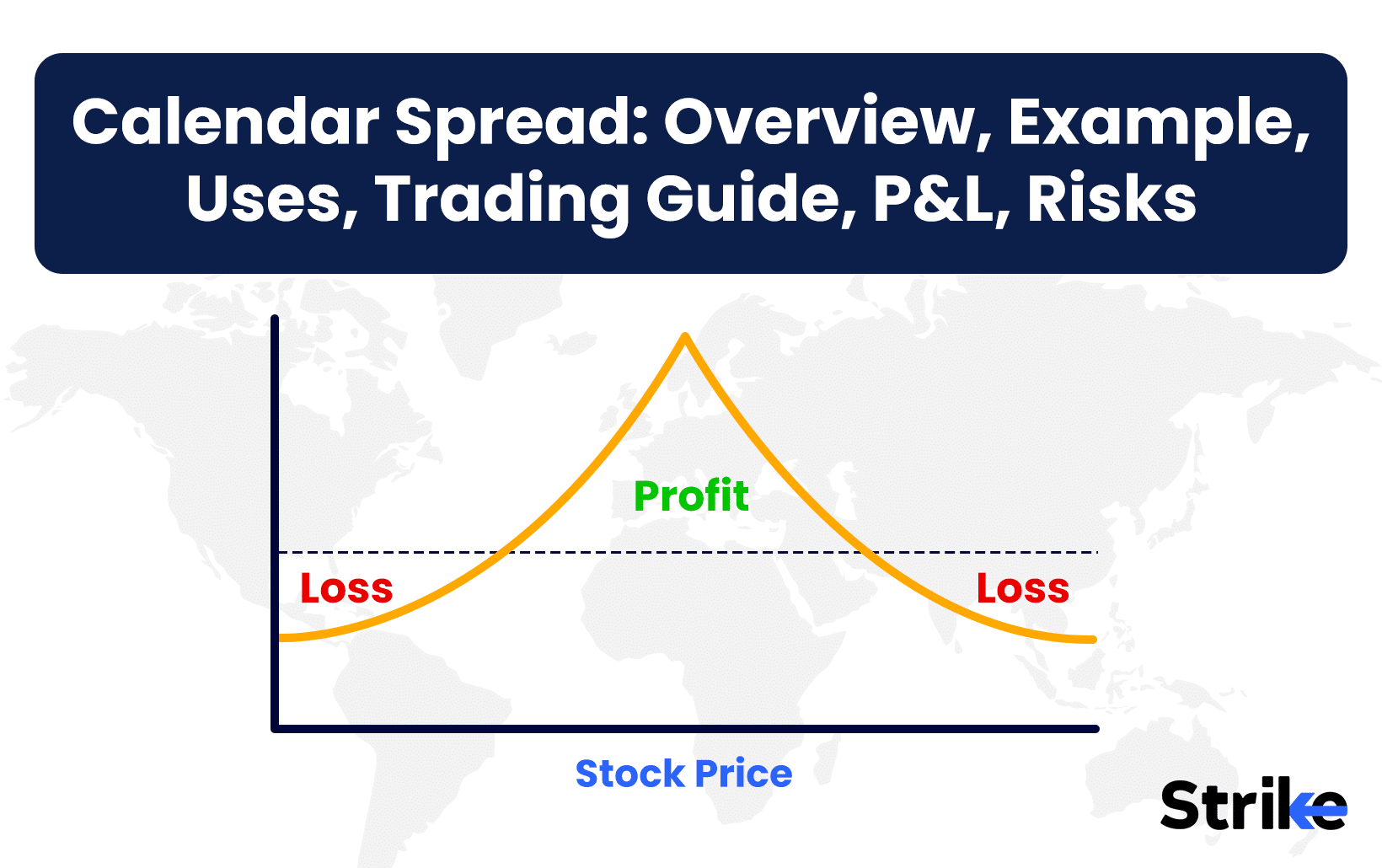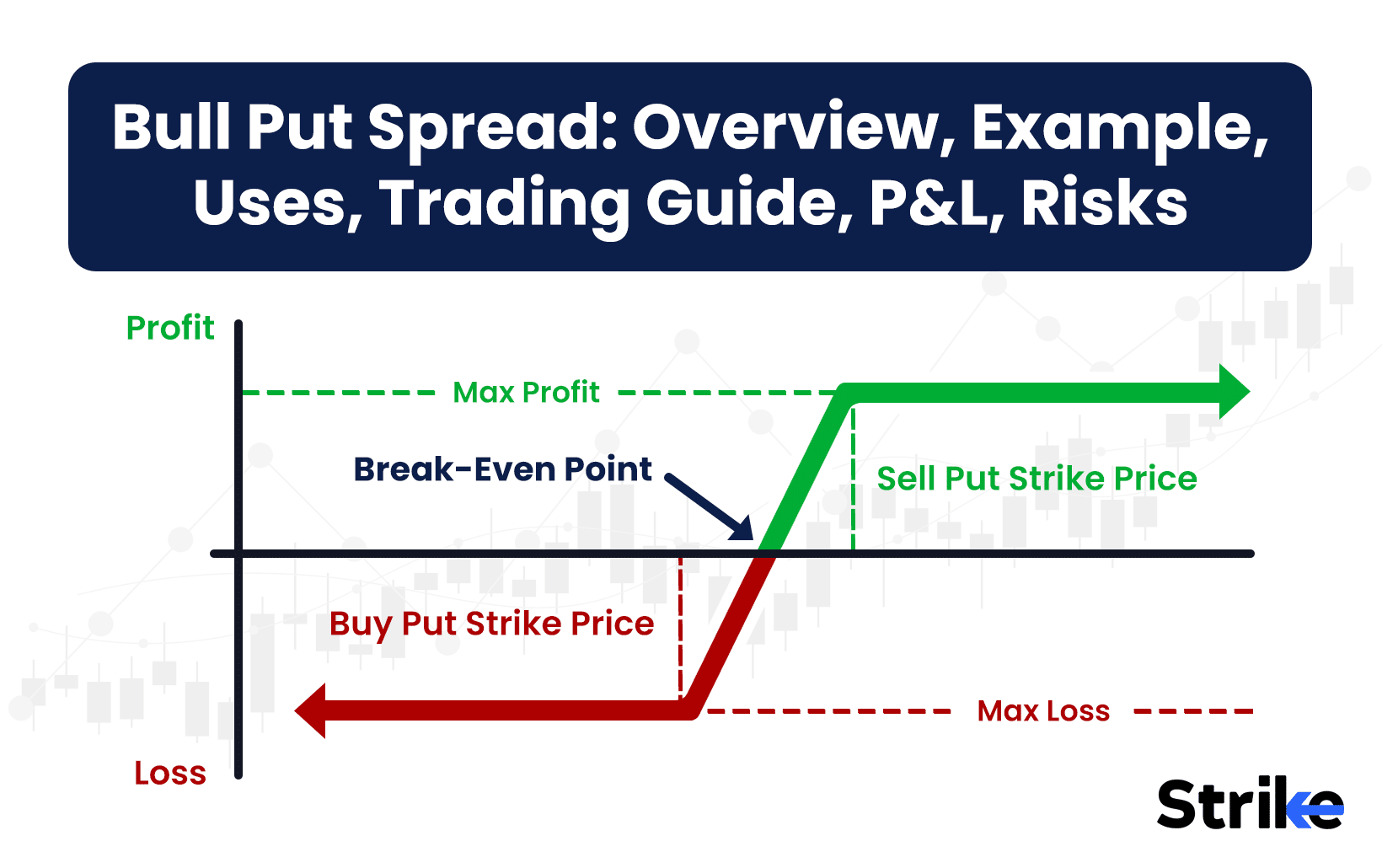Top Down vs Bottom Up Approach: Differences, Definitions, Examples, Limitations

Top down and bottom down are the two main approaches investors adopt when choosing stocks to invest. Top down and bottom down approaches present two contrasting ways of stock picking.
Top down approach looks at the overall broader economy rather than a single company. A trader choosing the top down approach looks to find a suitable sector to invest primarily.
Top down approach focuses on a single company. A trader who chooses this approach looks at the fundamentals and technical of a single company when deciding about investing or trading.
The main advantage of top down approach is that it allows identifying large scale economic and social trends that can help determine promising sectors for investment. However, solely relying on macro analysis runs the risk of missing out on strong companies that could defy broader market headwinds. Bottom up approach investigates individual companies rather than overall market or economy. It focuses on analyzing micro-level qualitative and quantitative factors like revenues, profits, management quality, and business prospects of specific firms.
What is the difference between Top Down & Bottom Up approach?
Below are the main differences between top down and bottom up approaches.
| Feature | Top Down | Bottom Up |
| Starting Point | Big picture: Global economy, national economy, industry trends | Small picture: Individual companies, stocks, or specific projects |
| Scope | Macroeconomic factors (GDP, inflation, interest rates, political climate, etc.) | Microeconomic factors (company financials, competitive landscape, management quality, etc.) |
| Direction of Analysis | General to specific | Specific to general |
| Primary Focus | Market cycles, sector performance, broad trends | Individual company strengths, business models, growth potential |
| Investment Philosophy | Exploiting market trends and cycles | Identifying undervalued companies with strong fundamentals |
| Typical Investors | Macro fund managers, tactical investors, trend followers | Value investors, fundamental analysts, long-term investors |
| Examples | * Sector rotation based on economic cycles * Investing in a global tech ETF during a tech boom | * Finding small-cap companies with high growth potential * Analyzing a company’s financial statements in-depth |
| Strengths | * Help identify broad market opportunities * Can be easier for less experienced investors | * Potential to uncover hidden gems undervalued by the market * Focus on company-specific factors can mitigate some market risk |
| Weaknesses | * Prone to missing strong individual companies outside ‘hot’ sectors * Can be vulnerable to sudden macroeconomic shifts | * Requires in-depth research and analysis * Can be time-consuming to evaluate individual companies |
| Ideal Usage | * Portfolio allocation across sectors or regions * Identifying broad investment themes | * Finding individual stocks with potential regardless of sector trends * Seeking long-term, fundamentally sound investments |
What is Top Down investing?
Top-down investing is an investment strategy that evaluates the broader economic environment first before analyzing individual companies and sectors. Top-down investing first examines macroeconomic factors such as gross domestic product, inflation rates, interest rates, currency movements and other indicators to get a sense of the overall health and trends in the economy. They then identify sectors and industries that appear poised to benefit based on these macro trends. Only after this top-level analysis do they research specific companies within the top-performing sectors identified.
How does Top Down investing work?
Top down investing works by starting with broader economic analysis before analyzing specific companies or industries. Top down investing begins by examining overall macroeconomic factors such as gross domestic product, employment rates, inflation levels, interest rates, currency movements, and other economic indicators both domestically and globally.
After understanding the overarching economic picture, top down investors then analyze individual market sectors or industries that are expected to benefit the most from the prevailing economic conditions. They research and forecast which sectors will outperform based on macroeconomic factors, such as choosing technology companies if GDP and employment are strong.
Once promising sectors are identified, top down investors then evaluate specific companies within those sectors that are well positioned to take advantage of upcoming sector growth. They study individual companies’ financials, products/services, management teams and competitive advantages to select potential holdings.
What Factors can affect Top Down investing?
Factors that affect top-down investing include macroeconomic conditions, industry trends, and geopolitical uncertainties. Top-down investing analyzes how these broader factors influence investment opportunities.
Macroeconomic conditions like GDP growth, inflation, interest rates, and fiscal/monetary policy impact the overall business environment of a country or region. Slowing GDP or high inflation could indicate weaker investment returns economy-wide. Top-down investors consider how these national/global economic trends impact different industries.
Industry trends also shape top-down decisions. Top-down analysts research which industry sectors are well-positioned based on long-term demand drivers and the competitive landscape. For example, technological advances may spur new opportunities in certain fields like renewable energy or biotech.
Geopolitical uncertainties likewise influence top-down perspectives. Events like global conflicts, trade wars, or political instability inject new risks into foreign markets. Top-down investors factor geopolitical stability into their analyses of international opportunities. Unexpected crises can rapidly damage investment prospects in certain nations.
What is an example of Top Down investing?
Thematic funds are a prime example of the top-down approach to investing. Thematic funds focus on identifiable trends and macroeconomic themes that are expected to play out over the long run. An investor would first analyze broad economic conditions and forecasts to identify potentially lucrative multi-year trends. They would then research individual business sectors and industries well-positioned to benefit from those trends.
For example, consider an analyst anticipating interest rates to remain low for an extended period, they identify real estate as a promising sector. Specifically, they foresee greater home buying and construction driven by easy access to financing. The top-down investor would then select real estate investment trusts (REITs) and homebuilder stocks that appear well suited to capitalize on more affordable mortgages and a hot housing market. Their portfolio would focus on real estate aligned with the prevailing low rate environment.
In another example, an energy transition toward renewable sources like solar and wind might signal the emergence of green technology as a long-term macro theme. A thematic fund manager applying a top-down strategy could evaluate renewable energy equipment producers, battery and storage solutions providers, and green energy infrastructure project developers that stand to benefit from the widespread adoption of solar and wind power. Their portfolio composition would centre around companies facilitating the projected transition to renewable energy generation.
When you should use Top Down approach?
You should use a top-down approach because it allows you to first analyze the overall condition of the economy and related macroeconomic factors before assessing investment opportunities in specific companies or industries. Starting at the highest level by researching trends in areas like GDP, interest rates, inflation, and other key economic indicators gives important context about the broader environment companies are operating in. Understanding the macro picture helps investors identify sectors and business activities that are best positioned to benefit from prevailing economic conditions and cycles.
What are the benefits of Top Down approach?
The main advantage of top down approach is that it allows investors to make investing decisions based on a broad assessment of the overall economic environment and outlook. By analyzing macroeconomic factors like GDP, interest rates, inflation and sector trends, top-down investors can identify overall favorable conditions and sectors before deciding on specific companies. This big-picture perspective helps minimize risks from factors outside of a company’s control.
Second, the top-down approach enables investors to make more efficient use of their time and research efforts. Rather than analyzing thousands of individual companies, top-down investors first filter the investment universe by evaluating macro conditions. This allows them to narrow their focus to the most promising industries and economic regions. With less companies to research, top-down investors can devote more attention to understanding the opportunities and risks of prospective investments.
Third, the top-down method promotes diversification because investors are less likely to put all their capital into one company or sector. By analyzing the broader economy, investors can select a balanced mix of investments spread across industries, regions and asset classes best positioned for prevailing conditions. This diversification helps lower overall portfolio risk.
Fourth, the top-down process empowers investors to adjust their portfolios in response to changing macro environments. Should economic data point to weaker growth ahead, top-down investors can proactively reallocate investments to more defensive areas before adverse impacts reach the company level. This responsiveness helps optimize returns over time.
What are the limitations of Top Down approach?
The main limitation of the top-down investment approach is that it sometimes miss out on profitable opportunities at the individual company level. Solely relying on this approach runs the risk of overlooking high-performing stocks. For example, focusing too much on overall industry conditions may cause an investor to ignore a particular company that is gaining market share through innovative products.
Top-down analysis also provides a broad brushstroke view without a deep examination of individual business fundamentals, financial statements, and management quality. Some companies with solid long-term potential may be neglected simply because they do not fit prevailing macro profiles. Lastly, overreliance on macro factors for portfolio construction limits diversification. Investing across different company sizes, business models, and geographical regions provides a hedge against macro-level risks.
Excluding bottom-up research means important alpha-generating stocks are more likely to slip through the cracks. A balanced multi-factor approach that combines both macro and micro analysis tends to identify the most profitable investment ideas.
What is Bottom Up Investing?
Bottom up investing is an analytical investment approach that involves analyzing individual company fundamentals to identify attractive investments. Bottom up investing begins with thorough research and analysis of individual companies rather than macroeconomic or market trends. Investors who follow a bottom up approach study various company-specific factors such as products or services offered, financial statements, management quality, competitive advantage, and overall growth potential. By meticulously examining Microeconomic determinants like revenue drivers, profit margins, cash flows, and return on equity, bottom up investors aim to identify well-managed businesses trading at reasonable valuations.
How does Bottom Up investing work?
Bottom up investing works by analyzing individual companies and securities within specific industries and economic sectors. Investors following a bottom up approach focus on thoroughly researching company-specific factors rather than relying solely on macroeconomic outlook or broad industry and market trends.
Key aspects bottom up investors examine include a company’s financial statements and metrics, products or services, competitive positioning and advantages within the industry, management capabilities and vision, profitability drivers and margins, cash flows, returns on equity and capital employed, and valuation based on earnings multiples. They dissect both qualitative and quantitative elements to understand a company’s operations, business model, financial health, and potential for future growth.
Bottom up investors also study historical financial performance trends to gauge if revenue, earnings and other operating metrics have steadily improved over time. Assessing working capital management, balance sheet strengths like debt/equity ratios, and the ability to generate sustainable free cash flows are important. They may examine proxies filed, transcripts of earnings calls and conferences to glean management interviews and strategy insights.
What Factors can affect Top Down investing?
The main factors that affect top-down investing include macroeconomic conditions, government policies, global events and market cycles.
Macroeconomic conditions like GDP growth, inflation, interest rates, and employment levels play a significant role in top-down analysis as these provide insights about the overall health of the economy. If macro data points towards weaker growth, top-down investors may reduce exposure to risky assets.
Government policies around fiscal spending, taxation, regulation and trade heavily influence industries and asset prices from a top-down perspective. Changes in tax rules or trade policies can boost or hurt certain sectors. Monetary policies by central banks regarding money supply and interest rates also get closely watched.
Global political uncertainties and events have top-down impacts. Geopolitical tensions, elections, changes in government, and military conflicts affect investor sentiment and the movement of capital across borders. International relationships and trade pacts play an important part in top-down portfolio decisions.
Market cycles represent another key factor. Top-down analysts track where different asset classes stand in their bull and bear cycles to understand investment implications. Timing entry and exits based on declining, rising or peaking markets is an essential part of the top-down strategy.
What is an example of Bottom Up approach?
An example of top-down investing approach is analyzing investment opportunities in the renewable energy sector. At the macroeconomic level, key factors to consider are India’s strong economic growth projections, rising energy demands of its large population and industrial sectors, government policies promoting cleaner energy and reduced dependence on fossil fuel imports.
The government has set an ambitious target of achieving 450 GW of renewable energy capacity by 2030, including 400 GW from solar power. Significant investments are planned for expanding transmission grid infrastructure as well. From a sectoral perspective, renewable energy has been identified as a high priority area. Industries like solar panel manufacturing, lithium-ion batteries, wind turbines, charge controllers etc. stand to benefit.
Some prominent companies in the Indian market that can be evaluated through top-down analysis are Adani Green Energy, Tata Power, Greenko Energy Holdings, Solar Industries India etc. For example, Solar Industries manufactures a wide range of products used in solar power generation. Being a leading solar EPC player with a strong order book, the company is well-positioned to capture growth opportunities arising from policies supporting solar energy adoption.
Its financials show consistent profitability with the steady balance sheet. Management has extensive experience and is focusing on technology upgradation to improve efficiencies.
When you should use Bottom Up approach?
The bottom up approach is well best used in situations where a stock-specific viewpoint is more important than macroeconomic factors. It involves an in-depth analysis of individual companies based on their fundamentals, financials, management quality and business prospects. The bottom up strategy works better for investors who have the time and expertise to deeply research different businesses at a granular level. It allows identifying attractive investment opportunities that may be undervalued or overlooked solely through a top-down macro analysis. The bottom up approach is also effective when macroeconomic trends are unreliable in dictating certain stock performances or sectors are too diversified to draw conclusions
What are the benefits of Bottom Up Approach?
The main advantage of using both a top-down and bottom-up approach to investing is that taking a top-down perspective allows investors to identify large-scale economic and market trends that help determine the most promising sectors and industries to invest in. Analyzing macroeconomic factors like GDP growth, interest rates, and fiscal policies helps gauge which areas of the economy may outperform. However, solely relying on macro analysis runs the risk of missing out on strong companies that could defy broader market headwinds.
Investors benefit from both macro-level guidance on where to direct capital as well as granular insights into companies poised to flourish through their own financial strengths, products, management qualities regardless of short-term economic cycles. Thoroughly examining metrics like revenues, margins, and returns at the stock level uncovers opportunities that may be overlooked through sector or country allocation alone.
Integrating top-down and bottom-up approaches strikes a balance that considers prevailing industry tailwinds highlighted through the macro lens as well as standalone profitability drivers of select firms identified via fundamental analysis. A blended strategy tapping into insights from different analytic perspectives helps optimize portfolio construction by diversifying across macroeconomic exposures and micro-level stock drivers.
What are the limitations of Top Down approach?
The main limitation of Top Down approach is that it sometimes miss out on opportunities at the individual company level. For example, a top-down investor analyzing automotive industry trends may ignore a car manufacturer pioneering affordable electric vehicles which sees increasing demand.
Macroeconomic predictions are not always accurate and prevailing conditions change quickly. This means opportunities at the company level may have already passed by the time adverse trends impact sectors. The top-down lens also provides a broad perspective without in-depth examination of qualitative aspects like management quality, competitive positioning and strategic vision influencing long-term potential.
Overreliance on macro factors limits diversification across company size, business models and geographies – thereby increasing exposure to macro risks. While top-down analysis helps optimize capital allocation based on prevailing trends, excluding bottom-up research assessing individual qualities means promising stocks may be overlooked.
When you should use both Top Down & Bottom Up approach?
You should use both Top Down & Bottom Up approach when constructing a well-diversified investment portfolio that can capture potential opportunities while managing risks. While top-down analysis helps identify promising macroeconomic and industry trends, it runs the risk of overlooking high-quality individual stocks with strong fundamentals. A bottom-up approach can uncover such opportunities by meticulously analyzing companies. However, relying solely on bottom-up research without regard to the overall economic picture may lead to exposure to systemic risks.









 Previous Article
Previous Article






No Comments Yet